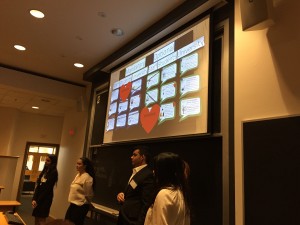 By Alexandra Rodney, Operations Team Leader
By Alexandra Rodney, Operations Team Leader
Since February, the Innovation Hub had the good fortune of serving as the “client” for the Business Leadership class at John Polanyi Collegiate Institute. This class is made up of Grade 11 and 12 students who, each semester, apply integrative thinking tools to help an organization solve a difficult problem. For the Innovation Hub, the students were tasked with the question of how to increase student engagement at the University of Toronto. The Business Leadership students were taught how to use integrative thinking tools by their teacher Rahim Essabhai (who recently won a Prime Minister’s Award for Teaching Excellence!) and Nogah Kornberg (of Rotman’s I-Think initiative). The students had the opportunity to visit the university on several occasions to interview students and Innovation Hub staff members as well as observe student life on campus.
On Wednesday, June 7th the Business Leadership students came to Rotman to give us a final presentation of their work. Aiman Flahat, school principal at John Polanyi, was in attendance along with TDSB trustee Jennifer Arp. Integrative thinking philosophy suggests that tension is the source of innovation, so the students walked us through the process of identifying the key tensions related to getting more students engaged in campus life. They also presented us with suggested solutions that combined the benefits of two opposing models.
Here are some highlights from the students’ presentations:
Team KHAAF : Team KHAAF looked at inclusive vs. exclusive ways of engaging students. They suggested that an ideal solution would focus on everyone feeling like they belonged but also making space for the needs of different kinds of students. We loved their suggestion to hold “Student Days” where all students would get a break from classes to participate in team-building and changemaking activities.
Team KnewHaven : This team examined student-centric and staff-centric models of engaging students and thought about where we might think about purpose and endorsement when designing programs for students. The KnewHaven team practiced using radical creativity when they suggested hosting student events in a blimp-like environment where students felt comfortable, excited and compelled to stay.
Team Rockets : Team Rockets impressed us with the work they did talking to 15 UofT students and alumni about their experiences at the university. Their integrative thinking work revolved around improving student-to-student and student-to-university connections. They proposed a new club run by students and staff that focuses on solving a social problem and that generates energetic student connections along with guidance for students.
Team ZARRS : Last but not least, team ZARRS focused on the question of what causes students to reach out for help during university. They examined mandatory vs. optional participation and focused on thinking about a solution that generated a feeling of security for students but was also easy to access. This team developed a prototype for a new social network called PROFit in which students could learn more about their professors.
If you’re interested in learning more about the teams’ integrative thinking processes and their final projects, please click on the team names above to reach their blogs (use the following details to access Team KHAAF’s blog: Username: bo4hmculmproject Password: bo4hm2017 and then click “Site Preview” to browse the blog posts).
We were blown away by the quality of the John Polanyi students’ work and plan to incorporate their suggestions into our planning process. Several of the students have chosen to attend the University of Toronto next year and we hope that they will continue to be a part of the work at the Innovation Hub!

0 comments on “John Polanyi CI Students’ Presentation of Learning”